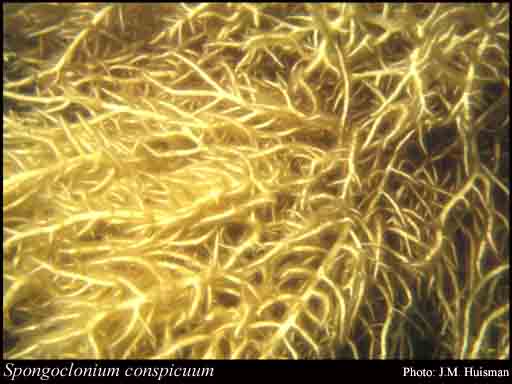- Reference
- Linnaea 515-516 (1855)
- Conservation Code
- Not threatened
- Naturalised Status
- Native to Western Australia
- Name Status
- Current

Scientific Description
Habit and structure. Thallus erect, medium red-brown to grey-brown, 15–30 cm high, irregularly branched with frequent radial branchlets giving a shaggy appearance to the linear branch and densely corticated with entwined rhizoids on all branches except near actively growing apices. Holdfast rhizoidal, 4–10(–15) mm across; epilithic. Structure. Axial cells 20–25 µm in diameter near the apex, becoming 200–250 µm in diameter and L/D 2–6(–10) near the base, producing a single branchlet radially from each cell, branchlets simple or usually basally branched, tapering only slightly over their length from 20–30 µm in diameter basally to (10–)14–22 µm in diameter just subapically, cells L/D 2–4, some cells laterally swollen; cortical rhizoids 8–45 µm in diameter, cells L/D 2–4, often with a lateral swelling. Cells multinucleate; rhodoplasts discoid, elongate in older cells.
Reproduction. Gametophytes dioecious. Carpogonial branches borne on short, 3-celled, lateral branches on limited indeterminate branches along the main laterals. The subterminal cell cuts off a 4-celled carpogonial branch, with the third cell bearing 2 opposite sterile periaxial cells; a distinct gelatinous sheath encloses the fertile axis, and the three sterile cells (apical, and 2 periaxial) enlarge considerably and become rounded, often remaining visible in mature carposporophytes. Post-fertilization an auxiliary cell is cut off from the supporting cell and the gonimoblast cell develops several rounded gonimolobes successively, lobes (150–)200–400 µm across, carposporangia ovoid, (15–)20–30(–50) µm in diameter. Axial cells below the developing carposporophyte produce an involucre of filaments. Spermatangial heads are borne on cells of branchlets in mid to upper parts of the thallus. Each head has 1–2 stalk cells and is 20–45 µm in diameter and 50–70 µm long, with an axis of 8–10 cells bearing whorls of 2–4 cells, the terminal initials producing ovoid spermatangia 2–2.5 µm in diameter. Tetrasporangia are borne on outer cells of the branchlets, on 1–3-celled pedicels (which may branch and form further tetrasporangia), subspherical and 25–45(–55) µm in diameter, tetrahedrally divided.
Distribution. Point Peron, W. Aust., to Waratah Bay, Vic., and the N coast of Tas.
[After Womersley, Mar. Benthic Fl. Southern Australia IIIC: 288–291 (1998)]
Distribution
- IBRA Regions
- Swan Coastal Plain.
- IBRA Subregions
- Perth.
- IMCRA Regions
- Central West Coast, Leeuwin-Naturaliste.
- Local Government Areas (LGAs)
- Augusta Margaret River, Dandaragan, Joondalup, Rockingham.